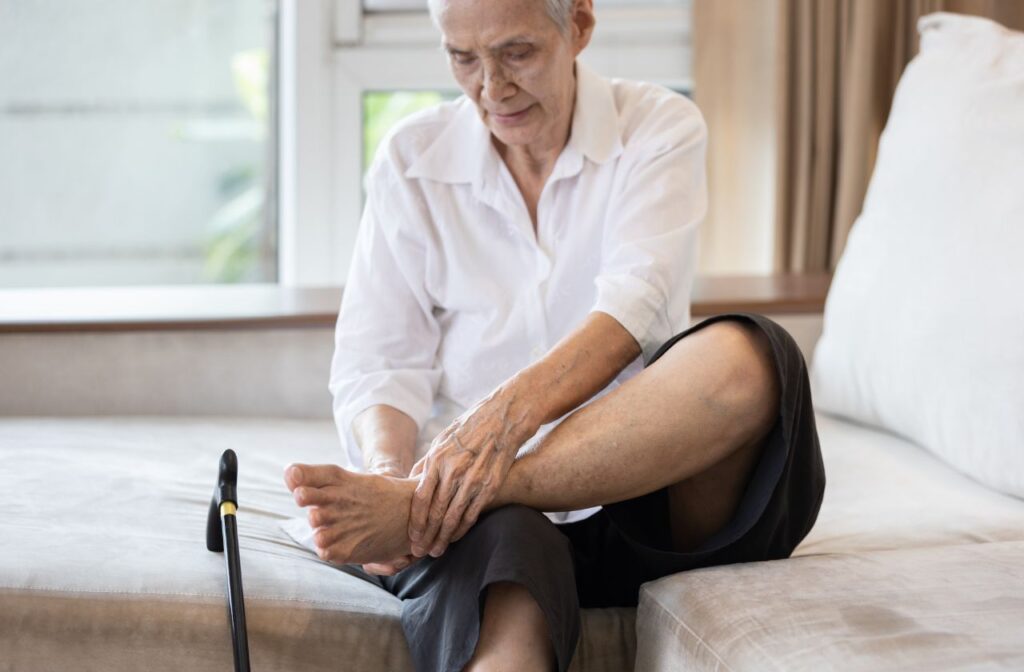While visiting the podiatrist is an excellent way to screen for problems and improve the feel and function of your feet, there are still a number of things you can do at home without the help of a professional. This is particularly important for the older population who are more at risk of foot problems. Here are some at home foot care tips for the elderly.

Foot hygiene and moisturising
The number one tip to avoid problems like fungal infections, ulcers and bacterial infections occurring is to keep the skin of your feet in good condition with proper foot hygiene. Proper foot hygiene means keeping the skin of the feet clean with regular bathing, ensuring they are well dried afterwards (especially between the toes) and applying a moisturising cream daily. This can be harder to do when we get older, so some tips to keep self-care up include:
- Purchase or make a small sponge/washcloth on a stick to help you clean your feet.
- Put a seat in the shower so you can reach your feet to clean them.
- If you can’t bend at the hip – there are some mats you can purchase to place on the shower floor and rub your feet over to clean.
- Sit down to dry your feet or place a towel on the floor to help you.
- Pharmacy’s sell long-handle cotton tips which can help you dry in between your toes.
- If you have trouble applying moisturiser – squirt some onto the top of your feet and rub your feet together. This may not be perfect, but it is much better than nothing!
- If you feel comfortable, ask a family member, friend or partner to help you.
Footwear choices at home
Even when you are at home, it is still important to have something on your feet. Wearing shoes or slippers around the house will protect your feet from foreign bodies and will reduce the pressure on the skin. This reduces the amount of callus (hard skin) and corns developing. Even wearing socks will help slightly with this, although something more sturdy is preferred (and is essential if you are diabetic). If you don’t want to wear shoes inside, there are a range of quality supportive slippers available for purchase both through Global FootCare Online and in-store at our clinics.

Keeping feet warm in winter
When the weather cools down often the most cold part of the body will be the feet. Blood has further to travel to reach your feet, and this only gets worse as we age and the blood vessels and arteries become weaker. So what is the best way to warm icy cold feet? Well, while tempting, avoid very hot items like hot water bottles, heat packs and electric blankets. These items, particularly if used overnight, have a high probability of creating a burn.This is because nerve function in the feet naturally declines slightly as we age, and you may not receive signals that the skin is getting too hot as quickly as normal. This is especially important if you have diabetes, as we know this generally speeds up the degradation of nerves.
Safer ways to keep warm include:
- Wear thick insulated socks – wool and natural fibres are great for maintaining heat while staying breathable.
- Wear two pairs of socks.
- Keep active – avoid sitting for long periods with your legs elevated, keep moving to encourage blood flow to your feet. Go for a short walk or if you want to stay sitting, draw the alphabet with both feet in the air.
- Consider trying a paraffin wax bath which will provide long-lasting deep heat to the feet

At home foot care by monitoring for problems in the elderly
All of the above tips are ways to hopefully prevent any problems from happening with your feet, however it is also highly recommended to check your feet for problems yourself too. We podiatrists call this a “daily foot check”. If you have diabetes, these are essential rather than just recommended due to the higher than average risk of complications. To complete a daily foot check:
- Sit down and examine the top of both feet – check for any discoloration to the skin or nails, cuts, redness, blisters or rashes.
- Check the bottom of your feet by either:
- Bending one leg to look at the underside of the first foot and perform the same visual check.
- If you are unable to bend your leg to check, either get someone else to check for you, or use a small mirror against the wall to look while you bend up your foot at the ankle.
- Spread your toes and check in between for skin breaks or soggy, flakey or red skin.
- Repeat the above two steps for the other foot.
- Before you put your shoes or slippers back on, check the inside for any sharp edges or debris which may injure your feet.
- See a podiatrist if you identify anything abnormal.


